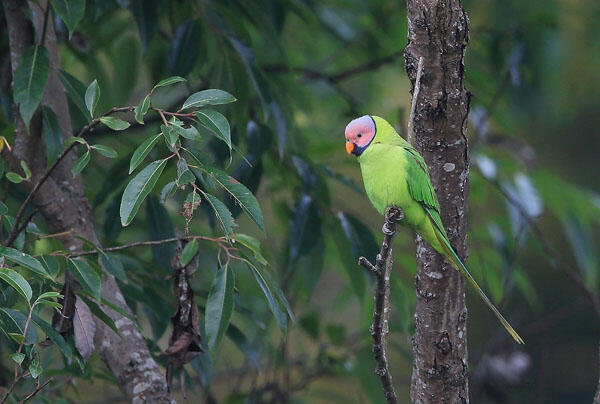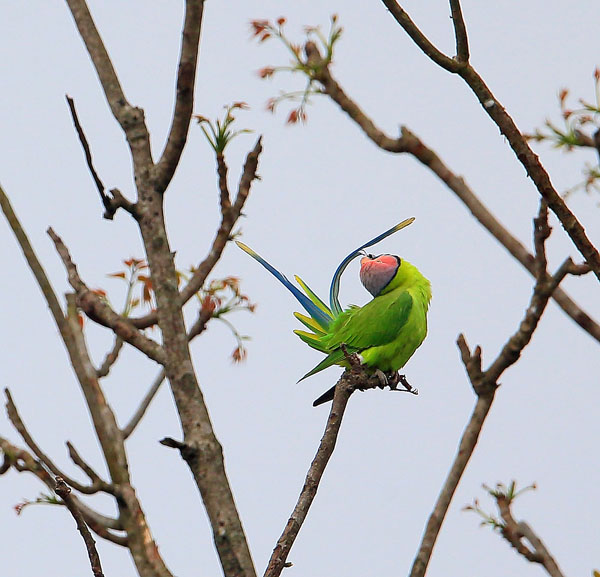Psittacula roseata
IUCN
LCBasic Information
Scientific classification
- name:Psittacula roseata
- Scientific Name:Psittacula roseata,Blossom-headed Parakeet,Rose-headed cockatoo, Purple-headed cockatoo
- Outline:Climbing birds
- Family:Psittaciformes Psittacidae G.Psittacula
Vital signs
- length:26-36cm
- Weight:85-90g
- lifetime:25years
Feature
The head color is different: the male is rose red, and the female is gray-blue.
Distribution and Habitat
In China, it was once found in southern Guangxi and western Guangdong, and may also be distributed in southeastern Tibet and its adjacent areas. Abroad, it is distributed in northern and eastern India and Southeast Asia.
It inhabits forest areas at about 1,500 meters, secondary forest areas, woodlands, farmlands, hills, and partially cultivated areas, dry and humid tropical grasslands. It especially prefers to move at the border between forests and farming areas. Most of the northern populations live in areas below 500 meters above sea level.
Appearance
The tail is long and the head is very round. The male has a rose pink head, a violet nape, a black throat that extends into a narrow black neck ring, small dark chestnut shoulder spots on the wings, and a blue tail feather with yellow tips. The female has a gray head, no black throat, and no neck ring. The difference from the similar-looking female gray-headed parrot is that the chin is different in color, the head is lighter in color, and the beak is different in color. The iris is yellow, the upper beak is yellow, and the lower beak is dark gray, and the feet are gray.
Details
The flower-headed parrot is a medium-sized bird, a typical climbing bird, with a strong and powerful beak, a hooked beak, a movable joint in the upper jaw, and a wax membrane at the base of the beak. It lives in subtropical and tropical deciduous forests, open woodlands and secondary jungles. It mainly feeds on seeds, fruits, flowers, nuts, pollen, plant buds and leaf buds; occasionally it goes to agricultural areas to forage for cereal crops.

Flower-headed parrots usually roam in pairs or small groups of up to 15. The location of nomadism depends entirely on whether there is enough food. Occasionally, they will gather with bearded parrots of the same genus. When flying, they will be accompanied by a very sharp cry, which is hoarse and harsh. Usually they move in small groups, but they will also gather in large groups, especially when there is enough food. They often forage with gray-headed parrots and Malabar parrots, sometimes causing damage to agricultural products.
The flower-headed parrot builds its nest in a tree hole. In the weeks before breeding, the male bird will protect the nest to prevent the invasion of some competitors such as the ring-necked parrot. The breeding season is usually between December and April, and the breeding season in Myanmar is from March to May; in Sri Lanka, it is sometimes from July to August. The number of eggs in a nest is usually 4-6. The incubation period is about 19-21 days, and the chicks are fully feathered at 7 weeks old.

Caged flower-headed parrots are very quiet and suitable for home breeding. They are shy when they are first raised and are not very destructive. They are sensitive to overly humid and cold environments. When they are first introduced, the temperature should not be lower than 20 degrees Celsius during the adaptation period. They are not very adaptable to new food at the beginning. After adaptation, it is advisable to provide various vegetables, fruits, seeds, grains and other foods.
Due to the large-scale logging and human capture of the forests on which the species depends, the species has experienced a rapid decline in number and is therefore considered a near-threatened species. It is listed in the second level of the "List of National Key Protected Wildlife in China".








